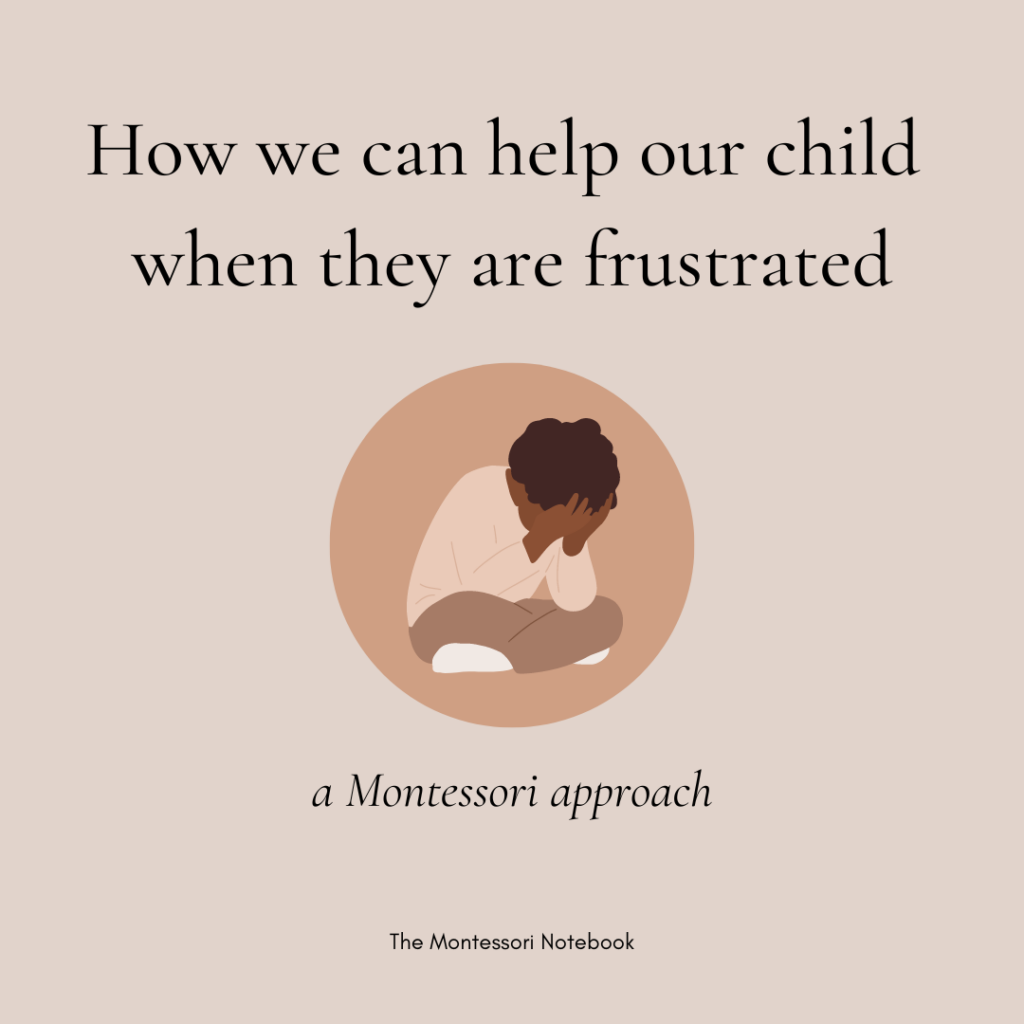When our child gets frustrated easily
“My son is 2, nearly 3, and is full of energy and confidence. However, he seems to get frustrated quite easily and it escalates fast for him so that I have to remove him from the situation or he will scream, hit my daughter usually, or us his parents and calls us names. He will calm down in a few minutes normally and come back in and apologise etc. Is there any way I can help him better, especially with the hitting?”
Dealing with a child’s frustration can be challenging. We often think, “If only they wouldn’t get worked up so easily” or “Why can’t they manage their frustration in a calmer way?” Viewing our child through a Montessori lens allows us to see them in a new way. We strive to understand them and support them through their frustrations.
Let’s explore how we can help them when they are frustrated, possibly prevent their frustration, and support them to calm down.

WHEN OUR CHILD GETS FRUSTRATED
1. Observe
As I often suggest, first let’s observe to get more information.
We can observe to find out objectively:
- when do they usually get frustrated? is it when they are tired, hungry etc?
- what do they get frustrated about? when they can’t do something easily? when they want to do something for themselves? when something doesn’t go their way? etc
- what do they do when they are frustrated? (in this example, the child hits or calls names or screams)
- is there another child/adult involved?
This can help us to understand the situation better and to consider how best we can support our child.
2. Give them as little help as possible (but as much as necessary)
There are a few ways we may be able to help our child when they are getting frustrated due to not having the skills.
- we can ask them if we can show them – we try not to take over what they are doing, but ask their permission, “Would you like me to show you?” “Would it be ok for me to have a turn to show you something?”
- we can give them a verbal instruction, eg, “push, push” “Would you like to try turning the knob?”
- we can make a list of instructions they can follow (this works best for older children, however, a list of drawing may help a younger child break down a sequence of steps)
Sometimes they will refuse any help. Then we will need to trust that they will come back to it in their own time to master when they are ready. If/when they get frustrated because they cannot do it, we can help them to regulate/co-regulate with them (see below).
3. Find other ways for them to have success
If we notice that our child becomes frustrated at the same thing, we can take some time to see if there is a way they can have success instead.
For example, if they are having trouble putting their shoes on the right feet, we could give them a guide to help them. This could be a mat with the outline of each shoe OR a peg which holds their shoes together in the correct way OR some stickers in the heel of each shoe to help them (the left half of a heart in the left shoe and the right half of a heart in the right shoe).
4. Observe and adjust the environment
I love to use the environment to help us. We can set things up for them to have more independence or to remove obstacles. As such we may be able to adjust the environment so they have less difficulty and therefore get less frustrated.
For example, if they get frustrated trying to get clothes out of their drawers without things spilling out, we could try having less clothes in their drawers so they can access their clothing more easily.
5. We can manage our expectations of them
Sometimes our child will get frustrated because we are offering them a choice that is too hard or that they are not ready for. Imagine we have seen a child on social media cracking an egg into a bowl. We may then inadvertently expect our child to be able to do the same but they may not have the same interests as this other child or we need to first scaffold the skills until they can manage cracking an egg by themselves.
There is a list of age-appropriate chores here. Remember that these ages are a guideline only – each child develops at their own pace.
6. We can manage others expectations of them
Similarly it may be grandparents or others who expect our child to do something that our child does not want to do or show interest in doing or is not yet on our child’s timeline. This can also lead to frustration. In these cases, I find it best to translate for our child, “It sounds like grandma wants you to XXX and it looks like you aren’t interested in that. Thanks for letting us know.”
7. Is there anything else that works?
We can also observe in ourselves how we react when our child gets frustrated. As much as possible, we can be calm ourselves. Then we can respond rather than react.
We can also be a model ourselves when we get frustrated. This can be a confronting self-observation exercise but we can notice if we get upset or angry and, instead, try to show our child we make mistakes and can try again.
It’s also ok for our child to be frustrated. They will learn that we are a safe person for them to calm down with. We will step in to stop any hitting, biting etc accepting all their feelings but not necessarily all behaviour.
HELPING THEM TO CALM DOWN
A frustrated child will often scream, have a tantrum, throw something, or hit/bite/push another child or ourselves.
If they are having a hard time, we can help our child to come back to calm, to regulate themselves or to co-regulate with them. I like to first offer them a hug. Some children will want us to hold them; others will push us away.
If they do want to be hugged, we can wrap them up in calm, we can breathe out, we can make some releasing sounds “ahhhhh,” we can rock our bodies, we can hum. We know what helps our child best.
Those who don’t want to be hugged, may want to be by themselves, or shake their body, or bang on something, or cry, or move. We can tell them at regular intervals that we are available if they’d like our help and, in the meantime, we make sure to keep them safe.
If they hit/bite or push, here are 3 steps to be a kind and clear guide:
Step 1 Keep everyone safe
We can say, “I can’t let you hit/bite/push them. It’s my job to keep everyone safe.”
We can put our body between them and another child who is being hurt. We can remove ourselves if they are hitting us. We can give them a pillow to hit (especially if they are banging their own head on the floor or other).
Step 2 We can be a translator
We can translate what they want to say and what the other child who has been hurt wants to say:
- Do you want to say “It’s my turn. It will be available soon”?
- You can say, “That’s my chair.”
- It looks like that hurt you. You can say, “Stop, I don’t like that.”
- You can put your hands on your hips and say, “It hurts when you hit me.”
Step 3 Help them to make a repair if needed
It’s important to help our child to take responsibility if they have hurt someone. With a young child, once they are calm, I will model making a repair and invite them to take part. For example, “Shall we get them a wet cloth for their cheek or would you like to get them a tissue?” I follow through and sometimes they help me.
An older child, once they are calm, may come up with their own way to make a repair with another. They may make a picture for the other person, say sorry, or make it up to them in another way.
Further reading: How to help a dysregulated child
Remember we cannot avoid all frustration. Nor would we want to. Our child needs safe opportunities to be challenged and to overcome these challenges. And we are there to support them if they get dysregulated from these frustrations.

Simone Davies has more than 20 years’ experience as an AMI Montessori educator. Simone is the author of “The Montessori Toddler” and co-author of “The Montessori Baby” and “The Montessori Child” books, comprehensive guides to raising children in a Montessori way. She currently runs parent-child Montessori classes in Amsterdam at her school Jacaranda Tree Montessori. She also has a popular blog, instagram and podcast “The Montessori Notebook” and is mother to two young adults.